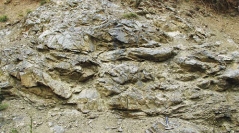

 Comptes Rendus Palevol
10 (1) - Pages 1-10
Comptes Rendus Palevol
10 (1) - Pages 1-10Devonian radiolarian ribbon cherts are found as olistoliths and as a thin (<100 m) tectonic slice in pervasively deformed sandstone and shale in a Triassic subduction-accretion complex (Upper Karakaya Complex) in Northwest Turkey. The subduction-accretion complex also comprises exotic blocks of Lower Carboniferous and Upper Permian limestone. It lies tectonically over a thick metabasite series and is unconformably overlain by little deformed continental to shallow marine sedimentary rocks of Jurassic age. The Devonian radiolarian cherts, along with the earlier descriptions of Carboniferous and Permian radiolarian cherts from the Karakaya Complex suggest the subduction of a Late Paleozoic ocean, the Paleo-Tethys, along the southern margin of the Pontides.
Devonian, Radiolaria, Chert, Karakaya Complex, Paleo-Tethys, Pontides, Turkey